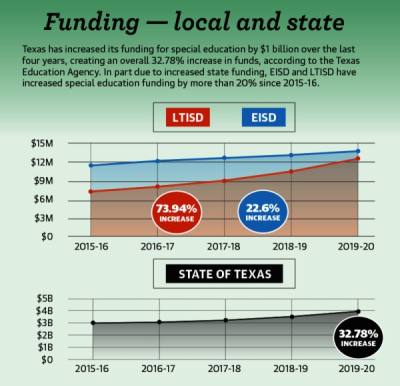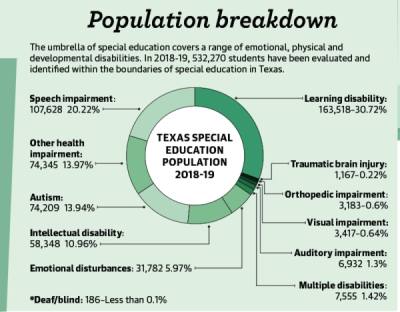During that Nov. 20 meeting, she requested that the board extend its parameters of fiscal responsibility in order to improve the recruitment, retention and respect of the special education staff.
“I know the administrators think that the rate of pay for teachers and support staff is competitive with other districts, but I think it’s not competitive when compared to the cost of living in the area and other available jobs,” she said, adding that many special education support staff positions are unfilled and have been for months.
She first approached the board June 19, after the district allocated a 4% raise off their midpoint salary scale, which many aides argued would not be enough to retain staff.
“Our job is physically, mentally and emotionally taxing, but we keep showing up,” Kuse said. “We show up for our kids, and we keep standing up for their best interests.”
New data has recently emerged from LTISD and Eanes ISD showing student enrollment in their special education departments is growing, but staff are not.
The shrinking pool of professionals
Schools nationwide are experiencing a shortage of special education teachers and aides, with 48 states struggling to staff their departments, according to Laura Abbott, director of special services at LTISD. Abbott’s claims are supported by a study from the National Coalition on Personnel Shortages in Special Education, which states 98% of U.S. school districts report deficits in special education staff.
LTISD experienced a 29% increase in its special education population during the 2019-20 school year. As of December, the district had nine aide and three teacher positions vacant, not including an additional seven positions approved in order to accommodate the recent enrollment increases.
A shrinking pool of professionals has been noticed not only by staff members, but also by parents within LTISD. They have also approached the board on multiple occasions to express their concerns related to retention rates and understaffing.
LTISD and EISD officials continue to address parent and staff concerns and have so far conducted department overviews, provided additional training and allocated funds for new positions.
Serving a growing department
At a packed parent symposium held at Laura’s Library on Nov. 13, Molly May, EISD executive director of special education, presented a report on the district’s special education department. It was the second symposium held by EISD that week in an attempt to gather parent feedback.
May said the privately funded report was an initial step in developing a plan to improve EISD’s special education department, which serves children with a range of intellectual and emotional challenges ranging from dyslexia to emotional disturbances.
The evaluation covered the district’s special education population growth and makeup and showed that over the last five years, EISD has seen about a 14% increase in its special education enrollment, which totals about 764 students for 2019-20, a 60-student increase from 2018-19.
Beyond a steadily increasing student population, May said a growing diversity among special education students is also becoming apparent.
“You’re seeing a higher percentage of different disabilities,” May said. “The number of students that have autism—I mean, that has increased dramatically.”
The number of students with emotional behavioral issues has also increased, she said.
The report acknowledges that the Westlake area has a larger number of private special education clinics, which may contribute to the district’s population makeup.
Heather Sheffield, EISD board member and parent of a child in special education, said part of the enrollment increase is due to the district’s positive reputation. Sheffield said she moved her own children into the district partly because of its resources.
May said EISD is not devoting a great deal of energy toward determining the reasoning behind its enrollment numbers—adequately staffing those positions is of greater importance.
Stenton and Associates, the firm that conducted the study, concluded EISD’s campuses are richly staffed with personnel who serve students with disabilities. Still, May said staffing certain paraprofessional positions remains difficult for all districts, including hers.
“Filling those positions is hard, and in fact, we are yet to be fully staffed this school year,” she said. “I don’t think that’s ever happened before.”
EISD hosted a paraprofessional job fair Nov. 14 to continue to fill some of the open special education aide positions as well as bus drivers, custodians and other paraprofessional jobs. According to May, as of Dec. 10, the special education department has not hired any employees as a direct result of the job fair, but they are working on a few leads.
Responses from EISD’s community outreach efforts have been presented to the Special Education Parent Working Group, who will provide suggestions for improving the department. This information will be included in May’s presentation to the board of trustees in January.
Officials at LTISD have also had difficulties filling aide positions. Since June, three aides and four parents have approached the board of trustees to report concerns with understaffing.
Amaya Mendenhall has two sons in special education at LTISD. Mendenhall said during a Sept. 18 school board meeting that her son did not have a special education teacher for the first five weeks of school. High turnover rates in the district remain a top concern for her since her son lost his entire team of staff this year.
“My guess is it’s just [the result of] a really high caseload,” she said. “I think every [special education] teacher is just so overworked. I think they genuinely really love their job, and they’re great at what they do ... they just can’t stay”
Aides and parents have publicly cited compensation rates and a high cost of living as the reason for the district’s turnover rates. During a district meeting at the beginning of the 2019-20 school year, LTISD aides requested a minimum salary of $20 an hour.
According to Abbott, the district is at the top of the market in terms of special education aide salaries, yet aides such as Kuse maintain she and her colleagues are not paid livable wages.
“We are at the top of the market, but that doesn’t mean that peoples’ importance of what they do is always recognized in salary,” Abbott said.
The board of trustees voted on a salary increase for special education substitutes Nov. 20, increasing the daily rate by $10 a day. According to Abbott, contracting substitutes allows the district to temporality fill some of its staff vacancies.
“We’re looking at additional training with people who substitute for us in special education,” Abbott said, adding the district looks for subs who are interested in becoming full-time teachers or aides.
The role of aides
Aides are an integral part of any special education department, and they provide tremendous support and log many hours with their assigned students, May said.
In August, LTISD aide James Galbraith told Community Impact Newspaper he has spent more than 4,000 hours with his student. This is a time frame he said is much longer than a general education teacher would spend with a child.
According to Galbraith, those hours are necessary for a population of students who crave consistency. Mendenhall agrees, and said her son thrives when working within an established routine and a familiar team.
“[Aides] spend a decent amount of time trying to pair with your kid, and then your kid gets used to them,” Mendenhall said.
At the beginning of the school year, Mendenhall said, her son worked with about six aides per day, as well as a general education teacher and resource teacher. But after working with district officials, she said, that number was ultimately reduced to two aides.
“It’s not an easy job, physically or mentally, so I would love for [aides] to be compensated accordingly,” she said.
Moving forward
Texas has increased special education funding by 27% since 2015, but area school district officials argue greater fund allocations are needed in order to properly serve a growing population of children.
Special education accounted for 17.32% of EISD’s 2019-20 budget, and while the district received an additional allocation from the state of approximately $107,000 for 2019-20, May said EISD was told not to expect that additional funding to continue.
Sheffield said she hopes the district will see an increase in state and federal funding, and she would love to pay the teachers and paraprofessionals a higher salary.
“They don’t come into this profession for the money; they’re in it because it's a passion, and they want to help children,” she said. “But at the same time, they do need to be paid appropriately.”
Kuse agrees and said the special education staff at LTISD spend every moment focused on their students, which she called the most vulnerable population of the student body.
“Our breakthroughs may not be as exciting as winning a state championship, but to our students and our parents, they’re life-changing,” she said. “Those breakthroughs affect them every day.”









